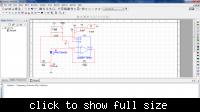Miltaridis
Newbie level 6
]I am using a pin photodiode bpw24r along with op amp ada4817 wired as a transimpedance amplifier. By biasing the diode at 5v my datasheet gives me a capacitance of 3.8 pf which combined by a feedback resistor of 75K with the rest of the circuit would give me a bandwidth at about 20MHZ .
My photodiode datasheet also states that the photodiode has a leakage current of about 2-10nA. So i assume that this current would be amplified by the feedback resistor and i would get about 750μV offset due to leakage current.Moreover the biasing current is in the pico range so it shouldnt create any offset too.
When i transmit a random Manchester modulated at 2MHZ signal i get the signal with a little bit distorted but with a major offset of about 200mv and my singal ptp at 800mv.
Here is my schematic .

Can someone point out the source of this noise ?
thx in advance
My photodiode datasheet also states that the photodiode has a leakage current of about 2-10nA. So i assume that this current would be amplified by the feedback resistor and i would get about 750μV offset due to leakage current.Moreover the biasing current is in the pico range so it shouldnt create any offset too.
When i transmit a random Manchester modulated at 2MHZ signal i get the signal with a little bit distorted but with a major offset of about 200mv and my singal ptp at 800mv.
Here is my schematic .

Can someone point out the source of this noise ?
thx in advance